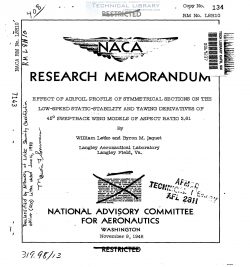naca-rm-l8h10
- Version
- 123 Downloads
- 746.43 KB File Size
- 1 File Count
- April 26, 2017 Create Date
- April 26, 2017 Last Updated
National Advisory Committee for Aeronautics, Research Memorandum - Effect of Airfoil Profile of Symmetrical Sections on the Low Speed Static Stability and Yawing Derivatives of 45° Sweptback Wing Models of Aspect Ratio 2.61

An investigation was made in the Langley'stability tunnel to deter-
mine the effect of airfoil profile _of symmetrical sections on the static-
and yawing—stability derivatives of three untapered wings of 11-50 sweep—
back- The wings had the following profiles normal to the leading edge:
biconvex (12 percent thick), NAGA 651—012, and 1mm 0012. The wings all
were of aspect ratio 2. 61.
The results of the tests indicate that, of the wings tested, the
biconvex wing had the lowest lift—curve slope and the lowest value of
maximum lift coefficient.
Of the derivatives resulting from an angle of yaw or a yawing velocity,
only the effective dihedral and the rolling moment due to yawing parameter
were seriously affected by change in profile shape. The values of both
these derivatives were reduced as the sharpness of the wing leading edge
increased. It appears that certain qualitative predictions of the trends
in these derivatives might be made for plainsweptback wings by using only
basic lift and drag data.
For the present low-scale tests the addition of an inboard nose
spoiler to the NACA 0012 wing caused a small increase of the maximum lift
coefficient, decreased the rearward shift of the aerodynamic center, and
caused a small reduction in the maximum value of effective dihedral. The
spoiler did not appreciably affect the other stability derivatives of the
NACA 0012 wing.
Estimation of the dynamic flight characteristics of aircraft requires
a knowledge of the forces and moments resulting from the angular motions
of the airplane. The relationship between the forces and moments and the
angular motions of the airplane are commonly expressed in nondimensional
terms known as the rotary derivatives. In the past these rotary deriv-
atives have generally been estimated from theory because of the lack of
a convenient experimental technique.
The recent application of the rolling-flow and curved—flow principles
of the Langley stability tuImel (references 1 and 2), however, has made
the determination of the rotary derivatives relatively easy. A systematic
research program utilizing these 'new experimental techniques has been estab-'
lished to determine the effects of various geometric variables on both rotary
and static stability characteristics.
| File | Action |
|---|---|
| naca-rm-l8h10 Effect of Airfoil Profile of Symmetrical Sections on the Low Speed Static Stability and Yawing Derivatives of 45° Sweptback Wing Models of Aspect Ratio 2.61.pdf | Download |

Comment On This Post